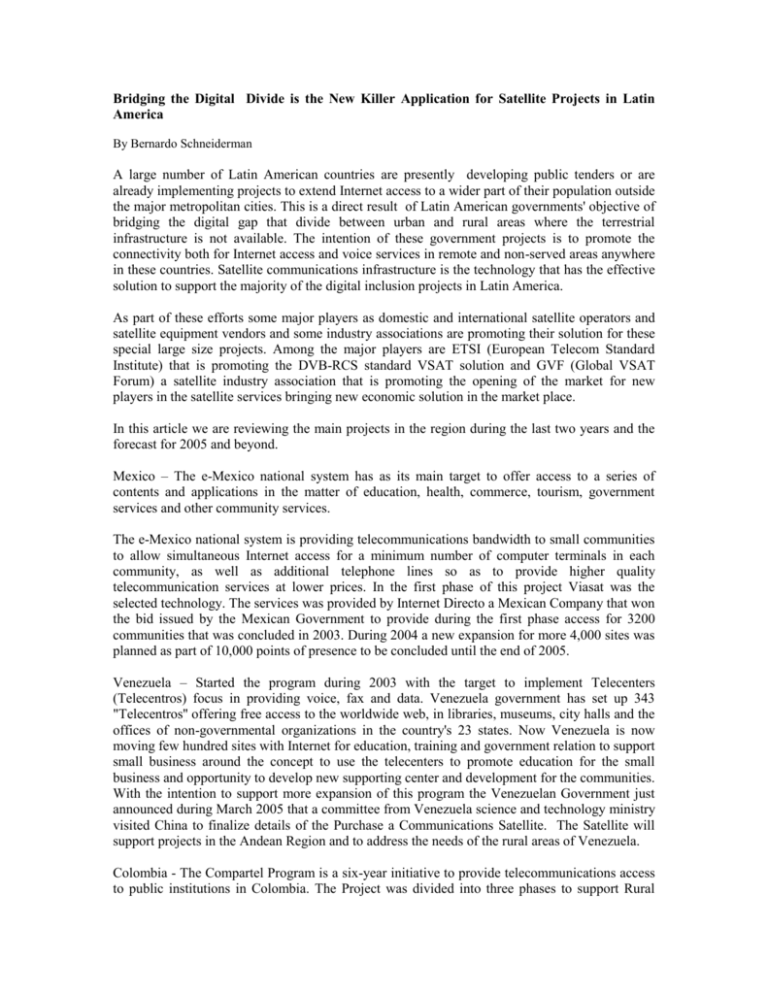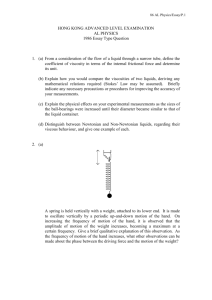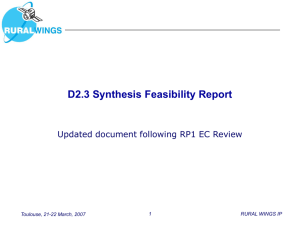Latin America
advertisement

Bridging the Digital Divide is the New Killer Application for Satellite Projects in Latin America By Bernardo Schneiderman A large number of Latin American countries are presently developing public tenders or are already implementing projects to extend Internet access to a wider part of their population outside the major metropolitan cities. This is a direct result of Latin American governments' objective of bridging the digital gap that divide between urban and rural areas where the terrestrial infrastructure is not available. The intention of these government projects is to promote the connectivity both for Internet access and voice services in remote and non-served areas anywhere in these countries. Satellite communications infrastructure is the technology that has the effective solution to support the majority of the digital inclusion projects in Latin America. As part of these efforts some major players as domestic and international satellite operators and satellite equipment vendors and some industry associations are promoting their solution for these special large size projects. Among the major players are ETSI (European Telecom Standard Institute) that is promoting the DVB-RCS standard VSAT solution and GVF (Global VSAT Forum) a satellite industry association that is promoting the opening of the market for new players in the satellite services bringing new economic solution in the market place. In this article we are reviewing the main projects in the region during the last two years and the forecast for 2005 and beyond. Mexico – The e-Mexico national system has as its main target to offer access to a series of contents and applications in the matter of education, health, commerce, tourism, government services and other community services. The e-Mexico national system is providing telecommunications bandwidth to small communities to allow simultaneous Internet access for a minimum number of computer terminals in each community, as well as additional telephone lines so as to provide higher quality telecommunication services at lower prices. In the first phase of this project Viasat was the selected technology. The services was provided by Internet Directo a Mexican Company that won the bid issued by the Mexican Government to provide during the first phase access for 3200 communities that was concluded in 2003. During 2004 a new expansion for more 4,000 sites was planned as part of 10,000 points of presence to be concluded until the end of 2005. Venezuela – Started the program during 2003 with the target to implement Telecenters (Telecentros) focus in providing voice, fax and data. Venezuela government has set up 343 "Telecentros'' offering free access to the worldwide web, in libraries, museums, city halls and the offices of non-governmental organizations in the country's 23 states. Now Venezuela is now moving few hundred sites with Internet for education, training and government relation to support small business around the concept to use the telecenters to promote education for the small business and opportunity to develop new supporting center and development for the communities. With the intention to support more expansion of this program the Venezuelan Government just announced during March 2005 that a committee from Venezuela science and technology ministry visited China to finalize details of the Purchase a Communications Satellite. The Satellite will support projects in the Andean Region and to address the needs of the rural areas of Venezuela. Colombia - The Compartel Program is a six-year initiative to provide telecommunications access to public institutions in Colombia. The Project was divided into three phases to support Rural Telephony, Telecenters and Broadband Internet access. In particular, the third phase of Compartel was designed to support Broadband Internet access for more than 3700 sites throughout Colombia. The project involves providing a high-speed Internet service together with access LAN support and PCs for local municipalities, schools, hospitals, and military sites in the five regions. Comsat International and American Inalambrica was selected during the mid of 2004 to provide the access through state-of-the-art Broadband VSAT technology in combination with fixed wireless equipment to enhance the local coverage zones. The program intend to expand the services during 2005 for few more thousand sites distributed between the projects named Compartel Rural Telephony Program, The Compartel Social Internet Program and the Compartel Broadband Connectivity Program for Public Institutions Peru – Peru was one of the first countries in Latin America implementing Rural Telephony via Satellite during the 90’s and satellite was already the solution. With the support of the World Bank developing agency a new program to expand Internet Access and VOIP to the remote areas is going to be issued during 2005. The new program target to provide not only distance education but also Internet for the community in remote and isolated areas. The project will be implemented in thousand of cities and villages in Peru. The intention is to use the best technology available together with WiFi technology to expand broadband access to 2,900 rural towns for Telephony and Internet access services for more than 2 million rural inhabitants during 2005. The amount of investment estimated for each SME is US$ 3,500 in addition to the US$ 15 million of subsidy provided by FITEL. Chile – Chile was another country where Rural Telephony via satellite was implemented during the 90’s. During the end of 2004 Subtel issue a bid for a special project for schools in isolated areas. The project was awarded for a group of companies to provide Internet access to school in more than 600 cities in the remote areas of Chile. The project didn’t specify satellite as access technology but the majority of sites were located in locations that satellite will be the only solution. During 2005 another project focus in the health area is planned for more than one thousand cities around Chile. Argentina- Argentina has been using satellite for rural telephony during the 90’s. During 2002 Argentina developed a project for the Internet to the Schools. The project was on hold for the last two years because of the economic situation in the country. But since the Government had starting finalizing the negotiation with the World Financial Community last March the potential for this project become a new phase for Argentina become positive for 2005. Brazil – Brazil started a program called GESAC to break the digital divide during the end of 2003 and Gilat was the operator selected to implement the services for 3,100 sites. Last December 2004 the Government awarded an expansion and upgrade for the program that is going to reach 4,400 cities to provide Internet and VOIP and potential distance Learning programs until the end of 2005. The new phase of the project was awarded to Comsat International, its Vicom subsidiary in Brazil. This program will provide an integrated communications network for broadband Internet access, Voice, Data, and Application Services to schools and municipalities throughout Brazil. This phase of the GESAC Program is to be implemented under a 30 months contract valued US$ 42 Million. GESAC is a Brazilian Government initiative for digital inclusion and connectivity for undeserved areas of Brazil. This second phase of the program adds new services and additional sites to the original project in which Comsat’s Vicom unit participated as a subcontractor. Brazil other project is being implemented by Telemar. Telemar is the regional Telco covering North, Northeast and SoutEast part Brazil. Telemar just selected Siemens and Nera to implement rural telephony via satellite with a DVB-RCS platform in more than 2,000 cities in Brazil to comply with the ANATEL universal telephony services in the remote areas of Brazil but will allow to provide internet connectivity at the same time. The Brazilian Government is planning to implement during 2005 a new challenging project named PC Connected. The main intention is to provide seven million computers for homes of the population of Class C (medium income). The same project will provide 1.8 million computers to SME (Small and medium enterprise). Both Projects the government intend to provide Internet Access with dial up or broadband and finance the equipment and services. In Addition of the Country by Country Projects the Institute of the Connectivity of the Americas (ICA) is implementing during this year a Regional project to reach all Latin America region called E-Link Americas. The project will use a mix of Satellite and WI-Fi solution to support projects in the education and health areas in the region. This project is developed in collaboration with the World Bank and the Organization of American States, as well as Canadian and regional companies, regulators, and governments. The potential for the Latin America in 2005 is very positive for this specific market segment that use Satellite to break the digital gap considering this country by country and regional projects. (insert Bernardo photo and bio—pickup from Index issue)








